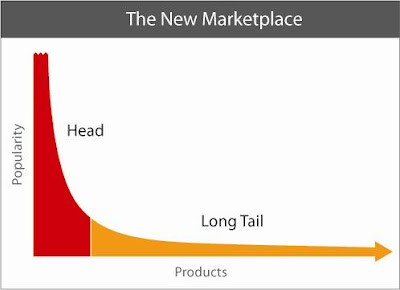For those who may be unfamiliar with the Long Tail Theory, here's a quick summary by Chris Anderson, editor-in-chief of Wired magazine, who coined the term in an October 2004 article and then later developed it into a book.

The Long Tail, in a nutshell
The theory of the Long Tail is that our culture and economy is increasingly shifting away from a focus on a relatively small number of "hits" (mainstream products and markets) at the head of the demand curve and toward a huge number of niches in the tail. As the costs of production and distribution fall, especially online, there is now less need to lump products and consumers into one-size-fits-all containers. In an era without the constraints of physical shelf space and other bottlenecks of distribution, narrowly-targeted goods and services can be as economically attractive as mainstream fare.
One example of this is the theory's prediction that demand for products not available in traditional bricks and mortar stores is potentially as big as for those that are. But the same is true for video not available on broadcast TV on any given day, and songs not played on radio. In other words, the potential aggregate size of the many small markets in goods that don't individually sell well enough for traditional retail and broadcast distribution may someday rival that of the existing large market in goods that do cross that economic bar.
The term refers specifically to the orange part of the sales chart above, which shows a standard demand curve that could apply to any industry, from entertainment to hard goods. The vertical axis is sales; the horizontal is products. The red part of the curve is the hits, which have dominated our markets and culture for most of the last century. The orange part is the non-hits, or niches, which is where the new growth is coming from now and in the future.
Traditional retail economics dictate that stores only stock the likely hits, because shelf space is expensive. But online retailers (from Amazon to iTunes) can stock virtually everything, and the number of available niche products outnumber the hits by several orders of magnitude. Those millions of niches are the Long Tail, which had been largely neglected until recently in favor of the Short Head of hits.
When consumers are offered infinite choice, the true shape of demand is revealed. And it turns out to be less hit-centric than we thought. People gravitate towards niches because they satisfy narrow interests better, and in one aspect of our life or another we all have some narrow interest (whether we think of it that way or not).
Dynamic Range Radio is definitely one of the little guys trying to carve out a niche in the long tail of the radio world, while Clear Channel is the best example of a short tail juggernaut playing only the most popular artists.
So how does all this relate to the eclecticness of my playlist? Imagine a graph like the one above, but replace "popularity" with "airplay" and "products" with "artists".
Pretty simple really.
To calculate the length of your musical tail, visit this site and enter your Last.FM user name. The site will take your top 50 artists and add up the number of times those artists have been played, then divide that number by the total number of tracks played overall, then multiply it by a hundred to get a percentage which represents the head on the graph. Subtract that percentage from a hundred to get the length of the long tail.
If I had fifty artists I really liked and over-played them like your local classic rock station does with Led Zeppelin, Pink Floyd, and Aerosmith, then my tail would be very short.
But Dynamic Range Radio currently has 744 unique artists in its playlist, so my top 50 artists only make up a small percentage of what I play overall.
26.5% to be exact.
In other words, 3/4 of the time, Dynamic Range Radio plays artists who fall into the long tail of my lesser played artists. So if you really hate one of my favourite artists, chances are you won't be hearing them that often.
If you want to see a list of my top 500 artists for the week, and how how often they were played, then visit my Last.FM profile. And if you rest your head on your right shoulder, you can even see a graphic representation of Dynamic Range Radio's long tail.






No comments:
Post a Comment
Note: Only a member of this blog may post a comment.